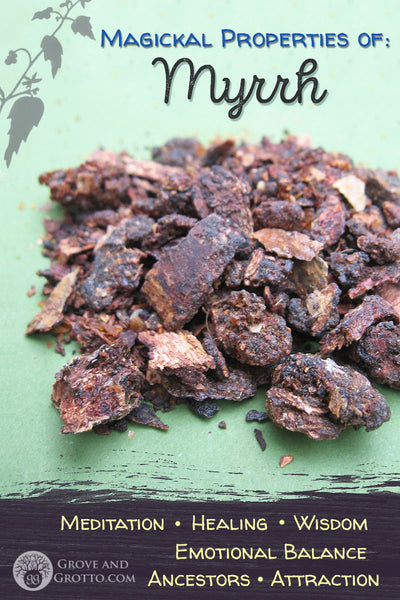
Myrrh is the sticky, dry resin of a certain forlorn desert tree, Commiphora myrrha. Myrrh is extracted by piercing the bark of the tree and returning later to collect the nuggets of dried sap. True to Myrrh’s reputation as a funerary herb, these pieces are sometimes called “tears.”
Ancient Egyptians used Myrrh, along with linen and natron, to embalm the dead. The resin both perfumes and preserves the body of the deceased. The Ebers papyrus (a document written around 1500 BCE contains over 800 medicinal formulas, many of which are based on a mixture of honey and myrrh. The antimicrobial and antioxidant properties of both substances are now known to science. Myrrh gum was also used by the ancients to treat infection, bruises, skin conditions, and toothache.
Myrrh trees grow wild in the shallow, rocky soil of desert regions. The main producers are Ethiopia, Kenya, and India. All are Commiphora myrrha, but the aroma and strength varies by region. The quantity (and quality) of Myrrh on the world market has been in decline for many years.
For the Witch’s pantry, Myrrh is available in resin and anointing oil form. There are also Myrrh-scented candles, incense, and bath products available. “Garden Myrrh,” also called Sweet Cecily, is an unrelated herb akin to Anise.
Myrrh essential oil is distilled from the resin and is moderately expensive compared to other essential oils. The pure essential oil is gummy and sticky. It needs to be thinned to be free-flowing. Myrrh oil contains a complex bouquet of chemical compounds and is not easily synthesized or mimicked.
Magickal Uses of Myrrh
Myrrh is one of the sacred incenses of the Bible. It is mentioned several times in the Old and New Testaments. Myrrh represents Christ’s suffering—the gift of Myrrh by the Magi presages his death and entombment. The evangelist Mark says that Christ was offered wine mixed with Myrrh prior to the crucifixion. Myrrh (mixed with Frankincense) is still used in the church incenses of many Christian denominations.
Myrrh is sacred to the Great Mother, whether she is called Mary, Isis, or Binah. (The names “Mary” and “Myrrh” both probably derive from the Hebrew word for “bitter.”) It is an herb of the ancient Goddess, especially in her aspect as She Who Mourns and who hears the cries of the mourning.
As an incense and anointing oil, Myrrh can lead to rich and rewarding meditation (especially introspection). It is used to heal personal sorrow and to connect with the dead and the Underworld. Myrrh is rarely used alone. Its character is somewhat malleable depending on what it’s blended with.
Correspondences of Myrrh
Myrrh is a complex scent, and there’s several different energies bound up in it. This ancient, multi-layered treasure just refuses to be pegged.
Myrrh thrives in full sun and was used in ancient Egyptian rites as an incense of Ra, so there are sources that argue for a Solar correspondence. The plant’s vicious thorns and dark, blood-like resin even lead some to reach for Mars. Greek soldiers carried vials of Myrrh to stop bleeding wounds—another tick in the Mars column.
However, most writers (including influential Wiccan author Scott Cunningham) have listed Myrrh as an herb of the Moon, especially the Dark Moon. This makes more sense, given the resin’s strong feminine history. The flowers are white (typical of Lunar herbs). A secondary planetary match would be Saturn, which rules darkness and endings.
Given Myrrh’s ancient connections to the Sun/Mars and its protective properties, some people link it to the element of Fire. But as a non-irritant and a healing balm, Myrrh is a misfit in the Fire category.
How about Water? Because the Moon pulls on the sea and rules psychic matters, a lot of Lunar herbs get automatically sorted onto the Water shelf. Myrrh certainly has some Watery attributes: Its ties to sorrow, contemplation, and the womb. Like tears of grief, Myrrh leads us into the depths of emotion in order to work its healing magick.
Yet Myrrh is not a traditional Water herb, either. It grows in the desert and bears small dry fruit. The usable part is brittle, dark, and viscous. I think of it more as a Moon/Earth herb than a Moon/Water herb.
The energy of Myrrh evokes both the dark ancient earth and the great black sea. Ritually, it is used to heal grief, nurture wisdom, and honor the dead.
Spells and Formulas with Myrrh
The fabled combo of Frankincense and Myrrh has never been improved upon. It makes an incredibly powerful and balanced incense for cleansing, protection, and more.
A musky-sweet blend of Myrrh, Patchouli, and Damiana is recommended by cat yronwode as an incense for sexual magick.
Burned before ritual, Myrrh rids the area of negative vibrations. It helps cultivate wisdom and self-healing.
The Greek Magical Papyri contain an attraction spell using Myrrh. The name of the beloved is chanted over burning Myrrh in order to compel her to be inflamed with love.
Precautions
Myrrh has been approved by the FDA as a food additive. However, concentrated forms such as essential oil should not be consumed internally.
The oil may safely (and beneficially) be applied to the skin when properly diluted. Myrrh can act as a uterine stimulant and should not be used by pregnant women.
Scent Profile: Bitter Sharp, Complex, Musty, Balsamic, Medicinal
Correspondences: Moon/Saturn, Water/Earth (And—what the hell—Sun/Mars/Fire.)
Occult properties of herbs are provided for historical interest only, and no outcome is guaranteed. Nothing on this website should be taken as medical or legal advice. Please use herbs responsibly.
Search our shop for Myrrh products, or browse more articles.
